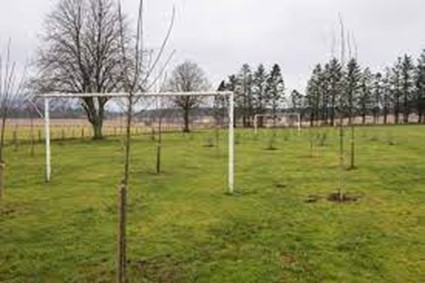Jon Burgess, Forestry Commission
With the increasingly imperative need to sequester carbon to mitigate the worst effects of climate change there is a huge push to plant more trees. It was quickly understood that the planting of trees should follow the mantra of Right Tree in the Right Place for the Right Reason to ensure that we did not do more harm than good, after all “the road to hell is paved with good intentions”. However, it is becoming clear that many people mean many different things when they use this phrase.
So, what are the possible different meanings behind this phrase? I think it is easiest to start at the end and work back.
Right Reason
Being clear about what benefits you hope to obtain by planting the tree (or making space for natural regeneration to thrive) is an important starting point. Planting trees to solve problems we face is called using Nature Based Solutions – we plant a tree, make sure it is protected and let nature do the rest.
In the 25 Year Environment Plan there were a set of 6 goals to be achieved. Trees can help with every single one of them:
- Clean Air: Trees act as a filter for airborne pollutants and help improve city air quality
- Clean and plentiful water: trees regulate surface water flows ensuring it is cleaner when it reaches our rivers, tree roots increase percolation of water deep into the soil helping replenish aquifers
- Reduced Risk of Harm from environmental hazards: trees provide shade and shelter to improve health of humans and livestock
- Using resources from nature more sustainably: timber is the oldest and original renewable building resource which we need to substitute for carbon hungry concrete and steel…
- Enhance beauty and engagement with the natural environment: Woodlands provide robust and attractive recreational areas
- Thriving Plants and wildlife: ancient woodland is the most biodiverse habitat in the UK, expanding these sites will achieve this goal
The list of things trees can do for us goes on… and we haven’t even mentioned carbon sequestration yet. In the recent report by Natural England comparing the ability of trees to absorb carbon dioxide against all other habitats showed trees can sequester up to 25 tonnes CO2 /ha/yr. The next closest habitat type was saltmarsh at 8 tonnes CO2/ha/yr. It is worth noting that grassland rated as neutral (0 tonnes CO2/ha/yr) as it was already at ‘peak’ carbon.
It is important to note the difference between sequestration (actively absorbing carbon) and storage (retaining carbon locked up generations ago). Only actively harvested woodland can continue to actively sequester carbon into the future.
With so many reasons why would we not cover the countryside in trees? Well, this is where we need to consider the next step…
Right Place

This can mean two things. Either: right for the tree to thrive as if it is not in the right place it will not be healthy; or right as judged by some other metric.
There are clearly some places that we would say are ‘wrong’ for trees – and not just this example from Scotland.
It is a fact that trees change the environment around them. They cast shade as they grow outcompeting other vegetation. It’s what they do as climax vegetation; you could even say it’s what our landscape ‘wants’ to do – this is the basic concept behind rewilding. Before humans were able to manipulate the environment around them artificially the whole of Europe was a giant boreal forest. Sadly, in the UK we had reduced tree cover down to just 4% by 1900 and have been trying to reforest ever since.

However, many of the habitats that we now value are the result of generations of human intervention, such as the introduction of grazing animals, hay cutting, controlled burning of the heath. All these practises served to remove or reduce the tree cover allowing species that thrived in more open sunlight to dominate. Insensitive tree planting might threaten these habitats.
Adding trees to a landscape almost always increases the biodiversity as the trees will support insects, lichen, fungi, provide nesting opportunities and fruit and nuts for food. However, where rare ground flora is present – such as wildflower meadows (which have declined by 97% since WWII) planting any tree planting that would shade the ground flora could potentially cause a loss of things we chose to protect.
In a similar way we know trees are planted for their amazing ability to sequester carbon, but if we were to plant trees on peat bogs then the drying effect of the roots will cause the release of previously stored carbon at a faster rate that the growing trees lock it up.
So, whilst the urgency to plant trees has never been greater and the understanding of the benefits more clearly vocalised than ever before we must pause for a moment to reflect and ensure that the location of new woodland has been carefully considered against a range of factors. This is why it is so important to plan the woodland well and consult widely before putting a spade into the ground. The Forestry Commission regulates new planting and is responsible for the Environmental Impact Assessment regulations that must be considered when planting, and we only grant aids plans that meet the UK Forest Standard, helping to ensure that the benefits from trees are maximised.
Right Tree
Now we know why we want to plant and where we will plant the selection of the tree species is much easier.
If you want to lock up carbon then chose a fast growing species.
If you want to use the timber to substitute for carbon hungry materials then one with good timber property that will grow straight will be best.
If you want to maximise biodiversity then a native species will probably be best.
In all cases a mixture of species will deliver a more resilient forest in the face of the future climate, and the increasing number of pests and diseases we are experiencing. Climate modelling tools are available from the Forestry Commission that help understand the potential ability of trees to survive through their long lives by comparing the predicted rainfall and heat in a range of climate scenarios. The sad news is that many native species will be struggling by 2080 in the south of England, knowing this is a risk we believe that a mixture of natives and trees that can be expected to thrive in the future climate should be considered. We know that the trees grow individually faster in such intimate mixtures as they utilise different aspects of the site and soil, with the non-natives helping to shelter and nurse the native species within the woodland.
For more advice on tree planting please contact your local Forestry Commission Woodland Officer:
www.gov.uk/government/organisations/forestry-commission
Photo credits:
- ScottishSun.co.uk
- Forestry Commission photo library
